#Hawaiian monk seal Mediterranean monk seal and Caribbean monk seal
Explore tagged Tumblr posts
Text
Caribbean Monk Seal
(Monachus tropicalis)
Too welcoming for their own good.

Last confirmed sighting in 1952.
Declared extinct in 2008.
Was the only seal indigenous to the Gulf of Mexico and Caribbean.
Extinct due to overhunting of their species and overfishing of their food sources.
Meet the Caribbean monk seal. These were a species native to warm, tropical waters. They were the only seal species found along the coasts of Texas and Florida.
In 1494, Christopher Columbus found these seals during a voyage. He referred to these as sea wolves. His crew killed all 8 that were spotted on the shore. This was the beginning of it all.
These were related to the endangered Hawaiian monk seals and Mediterranean monk seals. Caribbean monk seals were known for their docile nature and lack of a flight response, which made them vulnerable to colonizers who hunted them for their blubber.
They’d often be found in groups of 20-40 on land, or occasionally in caves. Their diet consisted of fish and small marine invertebrates. Overfishing of their food sources is also thought to be a cause of their extinction.
At the start of the 1900s, sightings became much more rare. The New York aquarium acquired 4 Caribbean monk seals. There were sparse sightings during the next few decades, and a final seal was found and killed by humans in 1939. It would be 10 more years until another was spotted, until 1952 — the last confirmed sighting to take place.
After extensive expeditions, the Caribbean monk seal was confirmed extinct. Alongside the Caribbean monk seal, a mite went extinct (Halarachne americana - Caribbean monk seal nasal mite), as it was unable to adapt to the loss of them. Additionally, the loss of the Caribbean monk seals left a big hole in their ecosystem as they were a prevalent predator. Not only that, but they were prey for larger species of sharks and potentially even transient orcas.
Their loss left a lot of questions that can never be answered. Not only that, but this serves as a reminder for the devastating effect that colonizers not only had on indigenous people — but also the local ecosystems and native wildlife.
61 notes
·
View notes
Text
Animal of the Day!
Caribbean Monk Seal (Neomonachus tropicalis)
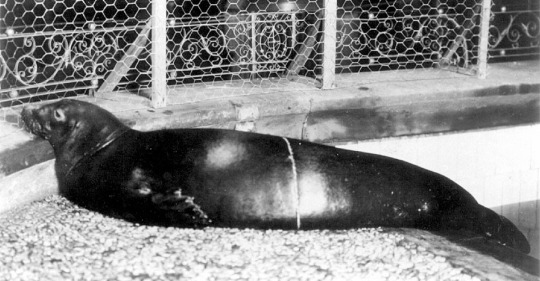
(Photo from the New York Aquarium)
Extinction Date- 2008
Habitat- Caribbean Sea; Gulf of Mexico; West Atlantic ocean
Size (Weight/Length)- 250 kg; 2.3 m
Diet- Crustaceans; Fish; Squid
Cool Facts- Caribbean monk seals were an extremely social species of seal. Also called the sea wolf, these seals lived in colonies of up to 100 individuals and organized their group based on age. The pups would gather together in large groups, lazing in the sun, while their parents went out to hunt. Unfortunately, Caribbean monk seals were extremely chill and lacked any fear of humans. Early colonists saw the seals as an easy food source and thousands were killed for their meat and fat that was used as oil in lamps. The second blow came when the fish and squid the seals relied on were majorly overfished. The endangered Hawaiian and Mediterranean monk seals are threatened by the same threats the Caribbean monk seal faced, but luckily strict protections are limiting poaching attempts and vaccination against disease is aiding in the conservation efforts.
Rating- 13/10 (Last seen in 1952 but not declared extinct until half a century later.)
#animal of the day#animals#mammals#seals#monk seal#tuesday#october 17#caribbean monk seal#biology#science#conservation#the more you know#extinct#extinctober
126 notes
·
View notes
Text
Y'all I recently learned that the Gulf of Mexico used to have a native seal, but they went extinct in the the 1960s, partially due to hunting and over hunting their food sources. They were called Caribbean Monk seals and are closely related to the Hawaiian Monk seal and the Mediterranean Monk seal, both of which are endangered
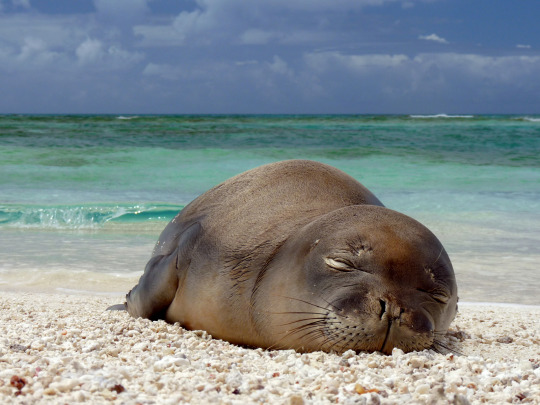
(Pictured: a Hawaiian monk seal)
#We used to have seals! We've been robbed!!#Also they played a vital niche in the gulf's ecosystem#maybe they'll introduce Hawaiian seals in the region to fill that niche and as part of the species conservation efforts#give them the manatee treatment; it's illegal to touch them unless you're approved as part of conservation work#I do know harbor seals have been seen more frequently on Florida's east coast so maybe they'll make their way into the gulf#but I think they need to cold water so I'm not sure how feasible that is
33 notes
·
View notes
Note
You seem to really like seals! Do you have a favorite seal species?
Yes!!! I used to want to be a Marine Mammal Biologist/Veterinarian so I hyperfixated on seals and sea lions in fourth and fifth grade.
My favorite is the harp seal! Classic seal.

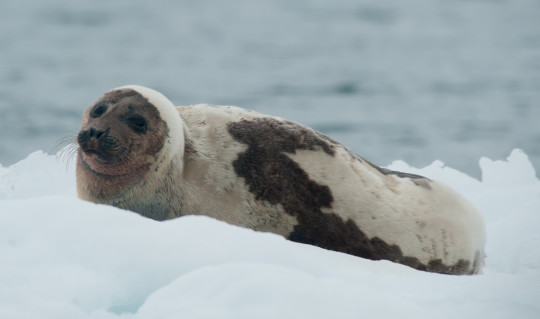
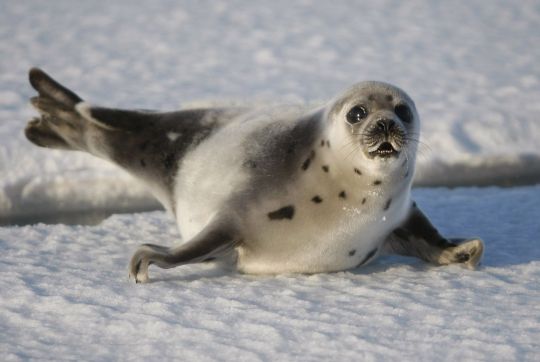
Many different patterns. The seal baby everyone thinks of
I also love harbor seals with their spotty coats. This is what Selkie Link is based on


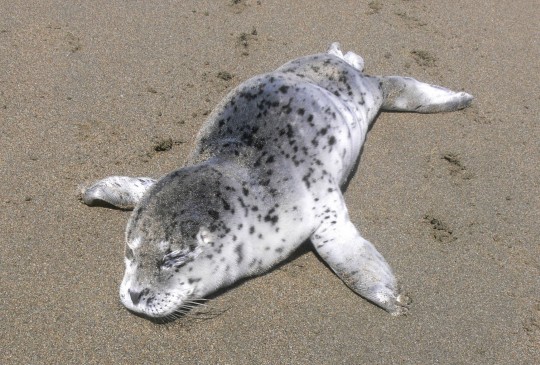
The babies even have the freckly spots!
And, of course, an honorable mention I can't believe I only recently learned about: the Baikal Seal.
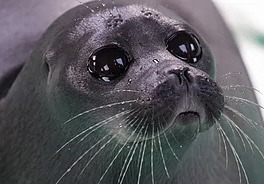



Look at them. Why are they like that. I love them
#also honorable honorable mentions. Hawaiian monk seals and Mediterranean monk seals. Hawaiin monks are VERY endangered#Mediterranean are also critically endangered. Caribbean monk seals are extinct :(#ask#anon
13 notes
·
View notes
Text
In May 2023, for several days, a Mediterranean monk seal has been attracting crowds and igniting a “media buzz” while hanging out at the beach right next to the historic city center of Jaffa in Tel Aviv, the major urban area of Palestine.
The Mediterranean monk seal is critically endangered and nearly extinct. This individual seal was named Tugra when spotted in Turkish waters in 2007. But local park administrators in Tel Aviv are calling her Yulia.
Some headlines are proclaiming that Yulia represents “the first time” that the species have been recorded making land on the shores of Palestine. But before the nineteenth century, there were certainly more seals in the area.


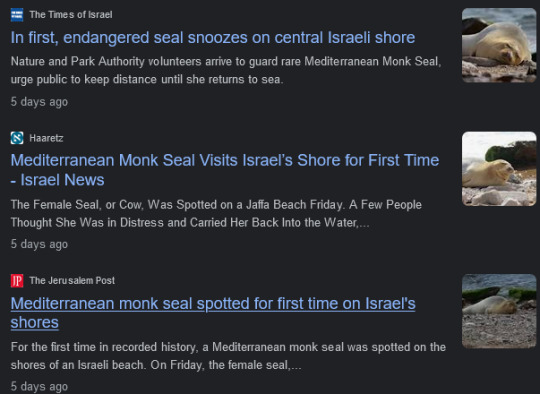
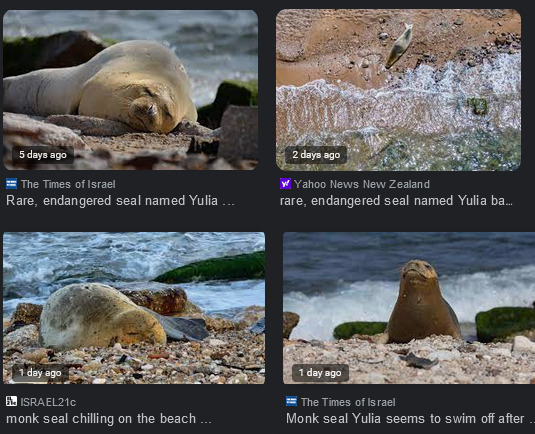
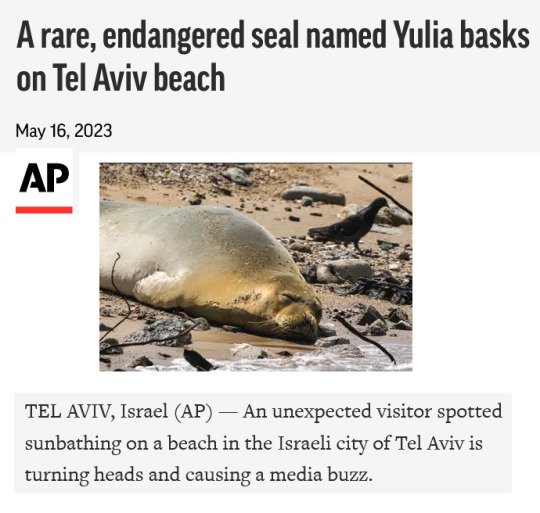
In the past few thousand years, Earth has been home to only three species of monk seals, and they are almost entirely extinct.
The Caribbean monk seal (Monachus tropicalis) is extinct. (They disappeared rapidly after Spanish, French, and British empires arrived in the Caribbean following Columbus; but the creature still lived in isolated locations until the middle of the twentieth century.)
There are about 1,500 surviving Hawaiian monk seals (Monachus schauinslandi).
And there are about 350 to 550 surviving Mediterranean monk seals (Monachus monachus).
Here’s the historic distribution range of the three species of monk seal before the nineteenth century:
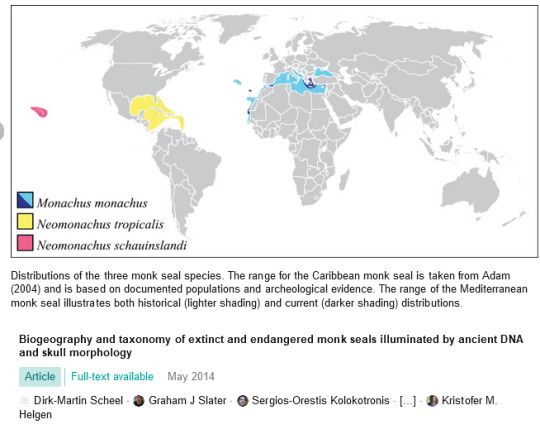
Historically, before local extinctions, the Mediterranean monk seal lived along the North Atlantic coast of Africa west of the Sahara; in the Black Sea; and all across the Mediterranean from Gibraltar to Alexandria, Cyprus, and Palestine. Here’s the historic and current distribution range of the Mediterranean monk seal (I slightly edited the map just to indicate the location of Tel Aviv):
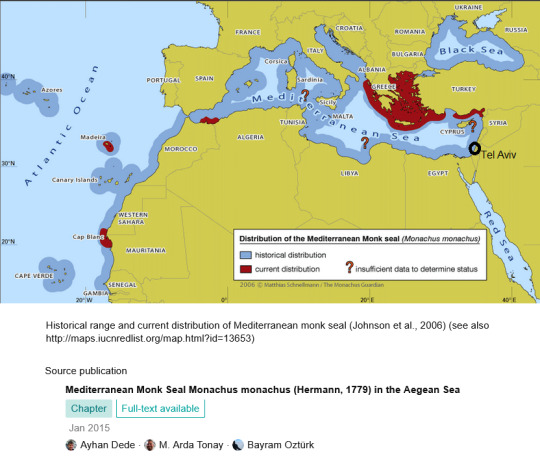
52 notes
·
View notes
Text
seal of the day: monk seal! they live in tropic climates and there are many subsets such as hawaiian monk seals, mediterranean monk seals, and caribbean monk seals. only around 1,700 monk seals remain due to over hunting since the middle ages :< they are super cute and i love their lil snouts <3




37 notes
·
View notes
Text
the main population of selkies is monk seals (not all monk seals are selkie but basically all selkies are monk seals) so there was three subspecies besides the kerry selkies, them being hawaiian, caribbean, and mediterranean, the caribbean monk seal wuz hunted to extinction in the past couple centuries though
3 notes
·
View notes
Text
Scientists thought these seals evolved in the north. 3-million-year-old fossils from New Zealand suggest otherwise
A fossil discovery in New Zealand has revealed a brand new species of monk seal that after referred to as Australasia house. We introduce the three million-year-old seal, Eomonachus belegaerensis, in a paper printed in the present day within the Proceedings of the Royal Society B.
Eomonachus is the primary monk seal species, dwelling or extinct, ever discovered within the southern hemisphere — and the oldest discovered wherever.
It’s rewriting all the pieces consultants thought they knew in regards to the evolution of “monachines”, a gaggle of seal relations comprising the 2 dwelling species of monk seal, the elephant seals, in addition to sure species of Antarctic seals.

We estimate Eomonachus belegaerensis was about 2.5 meters lengthy. Jaime Bran/Museum of New Zealand Te Papa Tongarewa, Creator supplied (No reuse)
On the point of vanishing
Monk seals are among the world’s rarest and most endangered marine mammals. There are fewer than 2,100 Mediterranean and Hawaiian monk seals alive in the present day. The Caribbean monk seal was hunted to extinction by the Nineteen Fifties.
Conservationists are actually scrambling to avoid wasting what’s left of Earth’s final solely tropical seals from disappearing.
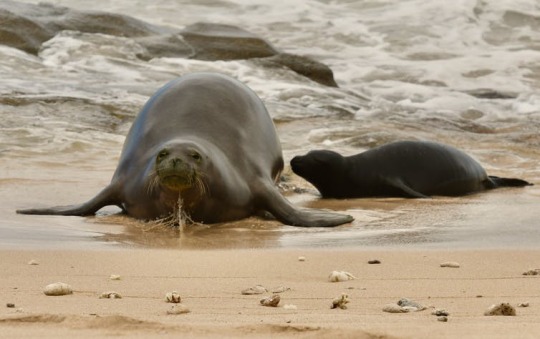
A Hawaiian monk seal emerges from the surf. That is an endangered species of earless seal (Phocidae household) that’s endemic to the Hawaiian Islands. Robert Harcourt (Macquarie College)
That mentioned, we might be fallacious to imagine monk seals have been doing simply tremendous earlier than people started exploiting them. How they fared over the previous few million years stays unclear. We additionally don’t know the place they originated, as fossils are few and much between.
Scientists historically thought all monk seals developed within the North Atlantic Ocean. Earlier than the invention of Eomonachus, monk seals had solely been discovered within the Northern Hemisphere.
Actually, most monachine fossils are discovered within the north, despite the fact that a number of dwelling monachines (Antarctic seals and elephant seals) reside almost exclusively within the Southern Ocean.
The surprising discovery of Eomonachus has fully flipped the evolutionary historical past not solely of monk seals, however of all monachines — by inserting all three within the Southern Hemisphere for the primary time.
Learn extra: Marine species are more threatened than we thought – and we’ve only looked at 3%
A monk seal from New Zealand
The restoration of the primary identified Eomonachus fossils got here within the type of seven skulls uncovered alongside the coast of Taranaki, on New Zealand’s North Island. The fossils have been retrieved by native collectors and donated to the Te Papa Tongarewa and Canterbury museums.
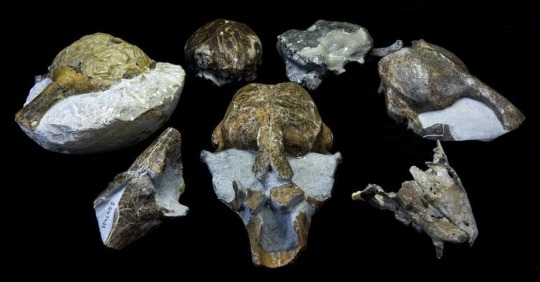
The seven fossilised skulls of the extinct monk seal species Eomonachus. Erich Fitzgerald (Museums Victoria)
Our group finally named the species Eomonachus belegaerensis. This interprets to “daybreak monk seal from Belegaer”. Belegaer is the fictional sea that lies west of “Center Earth”, the land from J. R. R. Tolkein’s Lord of The Rings trilogy which is commonly related to New Zealand.
However what have been monk seals doing in New Zealand three million years in the past?
Nicely, up to now, southern oceans have been lots hotter than they’re in the present day. And historic monk seals, very similar to their fashionable relations, lived in subtropical waters.
However till this year, few scientific research on extinct monachines had been performed within the southern hemisphere. That is doubtless why Eomonachus eluded scientists for therefore lengthy.
Learn extra: In a land of ancient giants, these small oddball seals once called Australia home
The evolution of monachines
Following the disclosing of Eomonachus, we determined to re-investigate the evolution of the monachines.
Our analysis signifies this group of seals developed within the Southern Hemisphere in any case. That is in distinction with each idea beforehand put ahead by scientists.
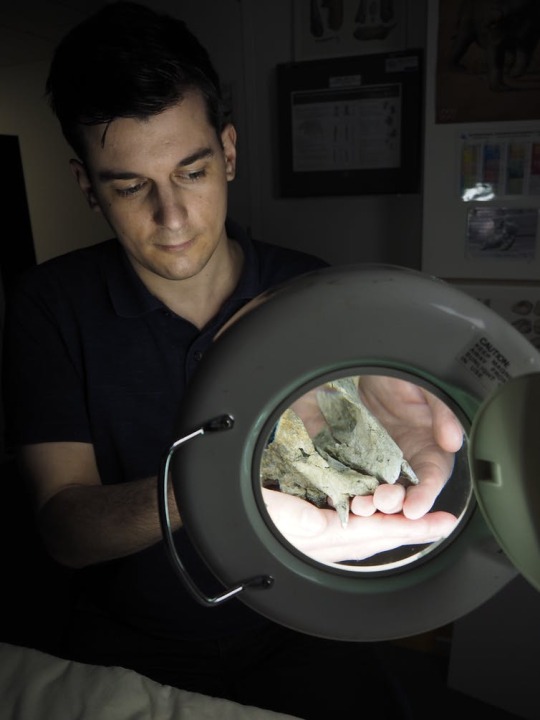
Monash College palaeontologist James Rule with one of many Eomonachus cranium fossils present in New Zealand. Erich Fitzgerald/Museums Victoria
If there’s certainly a southern origin for monachines, this could imply the group crossed the equator a minimum of eight instances all through its evolutionary historical past.
Nonetheless, the nice and cozy waters on the equator are broadly accepted to be a thermal barrier which is troublesome for marine mammals to cross.
If previous monachines did soar between each hemispheres, they might have had broad environmental tolerances that allow them do that. And this could have enabled their dispersal all over the world.
It’s troublesome to say conclusively whether or not fashionable seals share this trait, however we do comprehend it’s uncommon for them to cross the equator throughout their lifetime.
Local weather change and seal extinction
So why aren’t monk seals dwelling round New Zealand now?
About 2.5 million years in the past, marine megafauna skilled an extinction event, thought to have been brought on by a drop in sea ranges because of falling international temperature.
Earlier analysis has theorised this alteration in local weather spurred the extinction of many ancient seals within the Southern Hemisphere. This might have included Eomonachus, in addition to different extinct monachines.
This implies the world’s final two species of monk seal, vestiges of what was as soon as doubtless a widespread group, are additionally in danger from local weather change.
If sea ranges proceed to rise, the seashores monk seals rely on for resting and breeding might disappear. Rising temperatures might additionally disrupt food webs, making it troublesome for them to seek out meals.
Whereas the invention of Eomonachus is thrilling, it may also be thought of a cautionary story.
Source link
from Diaspora9ja https://diaspora9ja.com/scientists-thought-these-seals-evolved-in-the-north-3-million-year-old-fossils-from-new-zealand-suggest-otherwise/?utm_source=rss&utm_medium=rss&utm_campaign=scientists-thought-these-seals-evolved-in-the-north-3-million-year-old-fossils-from-new-zealand-suggest-otherwise
0 notes
Photo

Hawaiian monk seals are endemic to the Hawaiian Archipelago and are found primarily in the tropical waters of the northwestern Hawaiian island chain. Reproductive sites include Kure atoll, Midway atoll, Pearl and Hermes Reef, Lisianski Island, and French frigate shoals. Small populations also occur on Necker and Nihoa and breeding populations have been found on the main Hawaiian islands, also known as the windward Hawaiian Islands (Baker and Johannos, 2004; Antonelis et al., 2003). (Antonelis, et al., 2003; Baker, 2004)The Hawaiian monk seal (Neomonachus schauinslandi, formerly Monachus schauinslandi), is an endangered species of earless seal in the family Phocidae that is endemic to the Hawaiian Islands. The Hawaiian monk seal is one of two remaining monk seal species; the other is the Mediterranean monk seal. A third species, the Caribbean monk seal, is extinct. The Hawaiian monk seal is the only seal native to Hawaii, and, along with the Hawaiian hoary bat, is one of only two mammals endemic to the islands. These monk seals are a conservation reliant endangered species. The small population of about 1,400 individuals is threatened by human encroachment, very low levels of genetic variation, entanglement in fishing nets, marine debris, disease, and past commercial hunting for skins. There are many methods of conservation biology when it comes to endangered species; translocation, captive care, habitat cleanup, and educating the public about the Hawaiian monk seal are some of the methods that can be employed. Source: Wikipedia Checked our FB page https://www.facebook.com/StampSellersBKI #stamps #philategram #stamp #rare #filatelia #prangko #philately #worldstamp #philatelie #philatelist #special #postzegels #airmail #perangkokuno #stampsellers #selos #perangko #stampscollection #ice #stayhome #postales #shotoniphone #animal #seanimals #seal #walrus #monkseal #ccas #hawaiian #hawaii https://www.instagram.com/p/CDB9HZqJfkW/?igshid=1cmxzbfj7xm9r
#stamps#philategram#stamp#rare#filatelia#prangko#philately#worldstamp#philatelie#philatelist#special#postzegels#airmail#perangkokuno#stampsellers#selos#perangko#stampscollection#ice#stayhome#postales#shotoniphone#animal#seanimals#seal#walrus#monkseal#ccas#hawaiian#hawaii
0 notes
Photo

Reposted from @racingextinction - Did you know there were originally three known species of monk seal? The Caribbean monk seal has sadly already gone extinct but the Hawaiian and the Mediterranean remain. Tales of the Mediterranean monk seals date back to Ancient Greece. They were described as calm in the presence of humans, even trusting. This unfortunately made them vulnerable to hunting later on and now, with only an estimated number of 350 left, they are hardly ever seen. They remain the world's rarest seal and they are unfortunately #RacingExtinction https://www.instagram.com/p/Bx-OGzTn2eN/?igshid=19e007rasbyco
0 notes
Photo

Hawaiian Monk Seal resting on the beach in Lahaina, Hawaii. The Hawaiian monk seal is one of two remaining monk seal species; the other is the Mediterranean monk seal. A third species, the Caribbean monk seal, is extinct. 😍👍🏝 https://reallygood.com/community/media/hawaiian-monk-seal.243/ #reallygood #instagram
0 notes
Text
Pinnipeds are a group of animals with wide variety. They are aquatic relatives of terrestrial mammals belonging to order carnivora. Whales, dolphins, and other marine mammals are unable to move around on land as pinnipeds are able to. They have often been described as, “amphibious carnivora.” Otarids are capable of bringing their hindflippers under their body in order to walk, unlike phocid seals. They are abel to propel themselves in the water by alternating strokes of the hindflippers.
“According to the monophylyetic view, all pinnipeds evolved from a single ancestor, an arctoid carnivore” (Macdonald, pg. 147).
Mammals in general have evolved to function on land, but pinnipeds have evolved to be able to function in both land and water. There needed to be a lot of adaptations and adjustments for them to become the group of animals that they are today. They have an acute sense of vision, which is the sense which they rely on the most.
Most seals live in frigid waters, but monk seals live in tropical climates. They live in areas that are barely inhabited by humans. Their habitats are surrounded by coral reefs where they hunt for fish, lobsters, octopi, and eels. Female monk seals remain with their pups for six months. It is characteristic of pinnipeds in general to dedicate a lot of energy to their pups.
There are Mediterranean Monk seals as well as Hawaiian Monk seals. This type of seal has been around for at least 15 million years, and is regarded as a living fossil. Usage of the beach by humans drive them out of their home. Some of the earliest records of monk seals were described by Aristotle, and legends of sirens stemmed from these animals.
Caribbean monk seals became extinct in the 1950s. Pollution and hunting has been a longtime threat to these seals. Industry and agriculture also served as harmful to these creatures.
#Walruses#Seals#Monk Seals#Pinnipeds#Encyclopedia of Mammals#David Macdonald#Sea Lions#carnivora#Coral Reef
0 notes
Text
17 Endangered Ocean Species and Marine Animals
Speaking of endangered ocean species, the earth is now in the midst of its sixth mass extinction of plants and animals — the sixth wave of extinctions in the past half-billion years. The situation is almost as bad as that 65 million years ago when the dinosaurs became extinct. Despite the fact that extinction is a natural phenomenon, it has a background rate of one to five species a year.
However, scientists have reported that we are losing species at an alarming rate of 1,000 to 10,000 times the background rate. At this rate, we are seeing the loss of almost a dozen species every day and it will not be long before 50% of all the species will become extinct. That is a scary future indeed.
There is no one to blame for this calamity than us humans. We have been mistreating the environment to suit our needs, totally oblivious to the repercussions. As the need for water is increasing for various industrial or agricultural purposes, we are building dams without a second thought.
We dump our toxic wastes from factories and households into the water bodies. This has made the aquatic ecosystem the most affected areas and it is no surprise that so many fish and other aquatic animals have become endangered.
All the ecosystems are interconnected and interdependent in one way or the other so when there is an imbalance in one, it impacts the other ecosystems as well. As a result, human interventions are causing ecological imbalances in epic proportions.
Animals belonging to the terrestrial ecosystem like the Black rhino, the orangutan, Arum leopard, and the giant pandas, are under great danger. Likewise, turtles, salmonids and marine mammals like the blue whale, belonging to the marine ecosystem are also in danger.
The International Union for Conservation of Nature or the IUCN has declared hundreds of species across the world to be in the list of critically endangered species. This is mostly due to overfishing and climate change which in itself is a consequence of human negligence. This article covers some of those marine lives who are critically endangered.
The following are some of the aquatic animals or species that are on the verge of extinction.
Here is the list of 18 Endangered Ocean Species and Marine Animals
1) Green sea turtle (Cheloniamydas)
Green sea turtle (Cheloniamydas). Courtesy: https://ift.tt/2rP68Tl
The Green Sea turtle is an herbivore and falls in the list of the largest turtles. They are found in tropical and subtropical seas. The name comes from the color of the fat found under its shell. Their lengths can vary from 3 ft to 4 ft. The largest green sea turtle found had a length of 5 ft and weighed 395 kg. Similar to many other varieties of turtles, they leave their hatching beaches in search of food.
Unfortunately, they themselves are popular food items and even their eggs are sold as delicacies in certain parts of the world, leading to a gradual decline in their population. Careless fishing is also an indirect cause of their endangerment. No wonder, they are one of the most endangered ocean species.
2) Hawksbill Turtle (Eretmochelys imbricate)
Hawksbill Turtle (Eretmochelys imbricate)
Hawksbill Turtle is an object of heavy trafficking leading to an alarming 80% decline in their population just in the last century. Mostly found in tropical oceans and coral reefs they inhabit the oceans, gulfs, and seas of the world.
Their shells are beautifully patterned and colorful, thus making them extremely valuable in the black market. Hence, they are brutally killed for their shells. Many countries have banned the harvesting of their eggs, but it has turned out to be an effort in vain.
The degradation of coral reefs is also one of the prime reasons for the decline of their species. It is because this is their primary food. Also, they are vital for the existence of seagrass and coral beds because of interdependence. Marine conservatives believe that these turtles belong to a family of reptiles that existed on our planet for a hundred million years.
3) Kemp’s Ridley sea turtle (Lepidochelys kempii)
Kemp’s Ridley sea turtle (Lepidochelys kempii)
Kemp’s Ridley sea turtles are mostly found in the Gulf of Mexico. They often migrate to the Atlantic Ocean but come back to lay eggs. They are also known as the Atlantic Ridley. They are small and the number of them still alive is smaller. They have unique nesting habits. The females come to the beaches in large numbers to lay eggs. This process is called Arribadas.
They can weigh up to a hundred pounds and can live for as many as 50 years.
They have become extremely rare, mostly due to the damage to and consequently loss of their habitat, marine pollution, getting caught in fishing nets, etc. The harvesting of their eggs has been made illegal and research teams have taken up the project of conserving them through incubation and controlled environment suitable for hatching eggs.
4. Blue Whale (Balaenoptera musculus)
Blue Whale
Weighing at around 200 tonnes, the 100 feet long blue whale happens to be the largest living mammal on the planet. It belongs to the baleen whales and has at least three subspecies. Blue whales migrate from both poles in the oceans around the world and are at the top of the food chain. This gives the blue whale the most important task of maintaining a healthy marine environment.
Humans have created much disruption in this noble work of the whales as they are hunted for commercial purposes, despite the international ban in 1966, resulting in a sharp decline in their population so much so that their existence is threatened. Based on IUCN’s 2016 report, the estimated global population of the Blue Whale is 10,000 -25,000.
5. Fin whale (Balaenopteraphysalus)
youtube
The Fin whale is the second-largest mammal on the planet after the Blue Whale weighing at around 114 tonnes and having a length of 25.9 m. It is also known as common rorqual and like other whales has fallen prey to human greed. They are hunted for their fur and meat. As a result, their global population has gone down by quite a lot and now there are only 100,000 to 119,000 Fin Whales in the whole world.
Humpback Whale is another member of the rorqual species and just like the Fin Whale has been listed under the endangered marine species. Their population had gone down by 90% by the time a ban on whaling had been made official. Only 2,500 of them are still alive.
6. Vaquita (Phoeocna sinus)
youtube
The saddest thing about Vaquita is the fact that they are on the verge of extinction just within half a century of its first sighting. They are the smallest cetacean and are critically endangered. They live in the shallow murky waters of the Baja Peninsula in Mexico. A Vaquita can be recognized from the dark rings around its eyes, dark patches on its lips and a thin line extending from the mouth to dorsal fins.
The Gulf of California has witnessed a major use of gill-netting for fishing. Despite the fact that gill-netting operations are no longer carried out and have been so since the 1970s, their population keeps decreasing every year at an alarming rate of 15% per year. Reports say that there are only around 12 of these mammals left in the world ever since their population declined by a shocking 90% by 2011.
7. Hector’s Dolphin (Cephalorhynchus hectori)
youtube
Hector’s Dolphins happen to be the smallest and rarest dolphins in the world are also the most prominent dolphin in the genus Cephalorhynchus. They are found off the coast of New Zealand and are mostly sighted around the South Island. They have a broad body and black markings on their faces. Their throat and belly are creamy white in color. They move in groups of two to eight.
Trawl fisheries and bottom-set gill nets happen to be the main cause of their deaths and have led to a major decline in their population. The fishing nets are mostly responsible for their deaths. One of their most endangered of the sub-species happens to be Maui’s dolphin. Their population over the world is estimated to be just about 7000.
8. Hammerhead Shark (Sphyrnidae)
youtube
The Hammerhead shark belongs to the family Sphyrnidae and was given the name because of its “hammer” shaped head. The Hammerhead weighs up to 580 kg and their measure in length ranges from 0.9 to 6 meters. They are found in the tropical regions of the oceans around the world. They eat smaller fish, squid crustaceans and octopuses. They are dangerous hunters and are known to attack humans, even if they are unprovoked.
These majestic sharks are hunted for their fins and are brutally tortured as their fins are cut off from their bodies while they are alive. The remaining are thrown back into the water where they die from bleeding. The ban put on shark finning in many countries has not been of much use due to its high demand in the Asian markets which thrives on its illegal harvesting. This has drastically lowered its population and is continuing to do so.
9. Hawaiian Monk Seal (Neomonachus schauinslandi)
youtube
Hawaiian Monk Seal is one of the earless seals who live in the warm beaches of the North-western Hawaiian Islands. This characteristic separates it from other seals. The Caribbean monk seal has already become extinct. It belonged to the same family of monk seals. The only other member of the family remaining in the Mediterranean monk seal. Recent research suggests there are only around 1,400 Hawaiian Monk Seal remaining on the Islands now.
This is largely due to commercial hunting for meat, oil, and skin as well as the threat posed by predators including tiger sharks. They often get entangled in fishing nets and are heavily affected by marine debris.
10. Steller Sea Lion (Eumetopias jubatus)
youtube
Inhabiting the cold coastal waters of the North Pacific, the Stellar Sea Lion is the largest member of the Otariid family and the fourth largest of all seal species. It is also known as the northern sea lion. It was discovered and named after Georg Wilhelm Steller, a naturalist who first saw them in 1741.
Native Alaskans and Canadians hunt them for meat, oil, hides and other by-products. This coupled with the high risk of predation by Killer Whales has caused them to be on the brink of extinction. Reports suggest that their population has declined by more than 60% due to both natural and human threats since the 1960s. However, the good news is that their increasing population in recent years has resulted in their omission from the U.S. Endangered Species List in 2013.
Read more: What Is A Marine Biologist?
11. Ganges River Dolphin (Platanista gangetica)
youtube
The Ganges River dolphin is found in the Ganges-Brahmaputra-Meghna and Karnaphuli-Sangu river systems of Nepal, India, and Bangladesh. They have a long thin snout, rounded belly, stocky body, and large flippers. Their eyes lack lens and they hence are also referred to as the “blind dolphin”. Still, they use their eyes to locate themselves. The species has a slit on the top of the head, similar to a blowhole, which acts as a nostril. They are greyish brown in color. The younger ones are dark in color and as they grow old their color lightens.
They live in one of the most densely populated areas of the world and are slowly becoming extinct due to the number of dams that are being built every now and then. Apart from that, deforestation, pollution, and entanglement in fisheries and nets have steadily contributed towards the decline of their population. Also because of the barrages, the course of the river is also getting affected which in turn is affecting the species. It is estimated that only 1,200 – 1,800 of these species remain.
12. Spear Tooth Shark (Glyphis glyphis)
youtube
Spear tooth sharks are found in Queensland and in the Northern Territory of Australia. They are an extremely rare member of the river shark genus, belonging to the family of Carcharhinidae. They are mainly found in fast-moving, highly turbid waters that vary widely in salinity. They are grey-colored and robustly built having a short broad snout, tiny eyes, and a large second dorsal fin. They also have a black blotch near the tip of their pectoral fin.
Of course, their most outstanding feature is their large, triangular, serrated teeth in their upper jaw and narrow spear-like teeth serrated only near the end in their lower jaw. They measure to about 2.6 meters in length.
Their population has drastically declined due to pollution from mining operations, commercial fishing and recreational fishing in its brackish coastal habitats. Only 250-2,500 of them remain today.
13. Giant Devil Ray (Mobula mobular)
youtube
Giant Devil Ray (Mobula mobular) is the largest species of the genus Mobula. They are mostly found in the Mediterranean Sea and possibly the adjoining North Atlantic waters. They are taken as bycatch in many different fisheries. Due to low reproductive capacity, restricted range and high mortality as bycatch they had been categorized as Endangered in 2006. Their population is estimated to reduce by 50% over three generations pertaining to their high mortality range.
There are several other endangered marine species like the Hooded Seal, Great White Sharks, Dugongs, etc. Though many activists are trying to make a difference, most of their work is, unfortunately, going in vain. Maybe they should focus on conserving the species that are not endangered yet as that would be a far more achievable task, but sadly that is not what is being done.
14. Bluefin Tuna (Thunnus thynnus)
youtube
The bluefin tuna, also known as the aquatic bluefin tuna, the northern bluefin tuna or the giant bluefin tuna is a species of tuna fish. It belongs to the family of Scombridae. These fish are native to the Atlantic Ocean and the Mediterranean Sea. This species has already become extinct in the black sea and is on the verge of extinction in other parts of the world as well.
They can have a mass of more than 150 kg and yet this fish has an extraordinary ability to dive over 4000 ft. It is also a very popular dish all over the world and this is one of the reasons for its current situation. Other reasons for this are overfishing and not knowing about its lifecycle. Only about 40,000 bluefin tuna fishes are remaining today.
15. Galápago Penguin (Spheniscus mendiculus)
youtube
The Galápago Penguin is a species of penguin. It is the only species of penguin found in the north of the equator. They are named after the Galapagos Islands. They are small animals with a weight of not more than 2.5 kg and a height of 49 cm. It is one of the most critically endangered marine species on the planet with a remaining population of just about 2000. The main reasons behind this are climate change and overfishing. Recently, the introduction of domestic islands in the Galapagos Islands has been one of the prime reasons. Other threats to them include bycatch and pollution.
16. Florida Manatee (Trichechus manatus)
youtube
The Florida Manatee is a marine species that are found off the coast of Florida, USA. It is the aquatic relative of the elephant. They are generally 10 to 12 feet in length and can weigh as much as 800 kg. They are herbivores. Today, only 3000 to 6000 Florida Manatees remain. The major threats to their existence are pollution, climate change, habitat loss boat strikes, and commercial development. There are several organizations that aim at conserving this species. One can contribute by making donations or symbolically adopting them.
17. Sea Otter (Enhydra lutris)
youtube
The Sea Otter is an aquatic animal that belongs to the Weasel family. It is normally found along the coasts of the Pacific Ocean and in parts of Asia. They can grow up to a height of 4 ft and live for about 15 to 20 years on average. The main threats to sea otters are oil spills, habitat degradation, shark attacks, and hunting. Their population is about 106,000 all over the world. They are endangered species protected by law.
from WordPress https://www.maritimemanual.com/endangered-ocean-species-and-water-animals/
0 notes
Text
Seal colony sites, distribution range, and extinction timeline of Caribbean monk seal after European invasion:
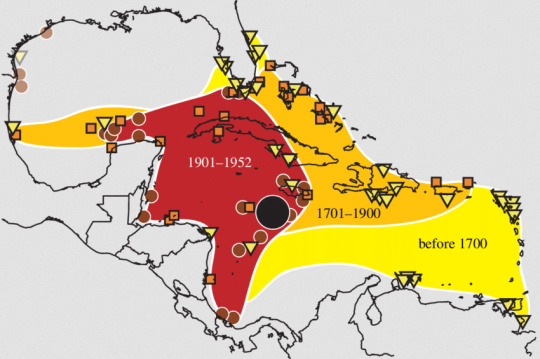

Gray circled areas are probable/possible locations of the breeding colony sites. Breeding sites predicted based on minimum distance of 300 kilometers between breeding colonies. [According to this paper, seal populations this size would’ve meant that there must’ve been many more fish prey living in much healthier Caribbean coral reefs. Other environmental historians disagree with this paper; they say, instead, that, by 1500, there may have been fewer seals.]
Text, both maps from:

Lil’ look at The Seal:
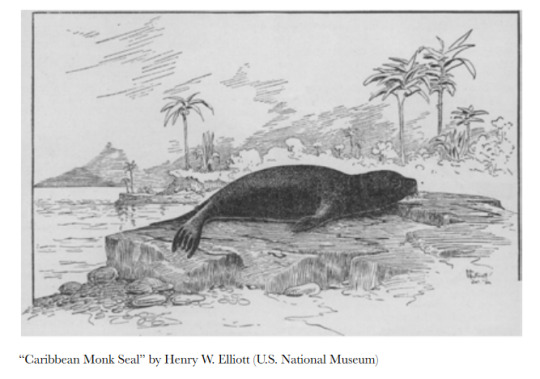
Separate article and timeline of extinction:
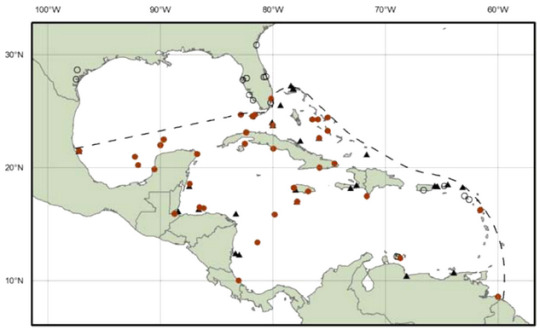

Upon review of the natural history and population decline of Caribbean monk seals, it is remarkable how a large population of an estimated few hundred thousand seals in the Caribbean region was so rapidly extirpated [...]. [T]he genus Monachus included 3 allopatric species: M. tropicalis (Caribbean monk seals), M. schauinslandi (Hawaiian monk seals), and M. monachus (Mediterranean monk seals), of which the two surviving species are currently in danger of extinction. [...] Caribbean monk seals were the only pinniped commonly found in the southeastern United States and wider Caribbean region, including the Gulf of Mexico. [...] Caribbean monk seals were first reported during the second voyage of Columbus in 1494 (Kerr1824), when at least 8 animals were killed for their meat. This event in history marks the arrival of Europeans to the Caribbean [...]. Accounts of Caribbean monk seals were usually from isolated islands, keys, and atolls surrounded by shallow, reef-protected waters [...]; nearshore rocks; and only occasionally from mainland beaches and inlets [...]. Prior to depletion, the species was reported to have hauled out in groups of up to 500 individuals [...]. Due to their hauling out behaviour, Caribbean monk seals were readily and intensively exploited as a source of oil by Europeans colonizing the region, and to a lesser extent for food, scientific study, and zoological collection. Seals were presumably hunted in smaller numbers during the1500s and 1600s, with intense exploitation beginning in the latter 1600s [...]. Large numbers of seals persisted in some areas as late as the early 1800s and were also hunted for food by sailors and fishermen for meat until about 1885. [...] It is believed that expeditions to the Triangle Keys region of the Yucatan peninsula led to the extirpation of what may have been one of the last remaining large colonies of Caribbean monk seals in the wild. [...]
However, the last confirmed sighting occurred in 1952 at Seranilla Banks in the western Caribbean
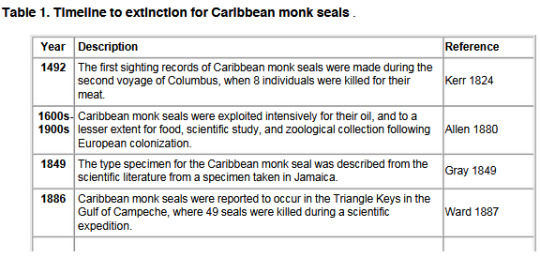
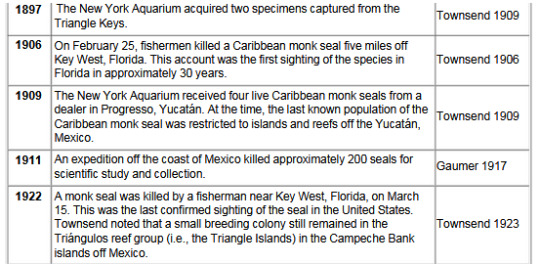
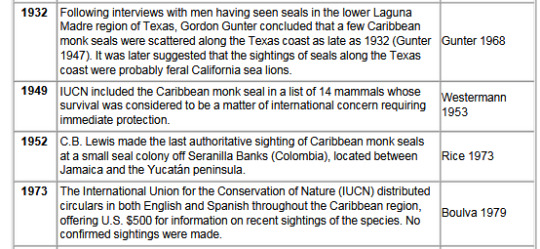
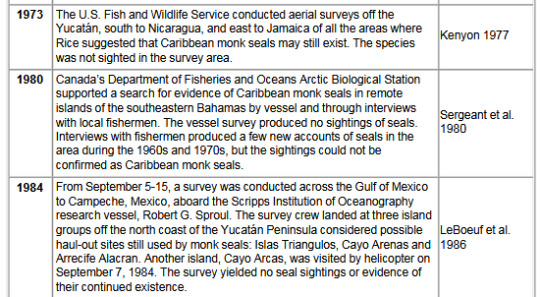

---
Text, map, timeline graphic all from:
Kyle Baker. “So many seals, so little time:The rapid extinction of the Caribbean monk seal.” The Monachus Guardian - Monachus Science Vol 11. June 2008.
16 notes
·
View notes